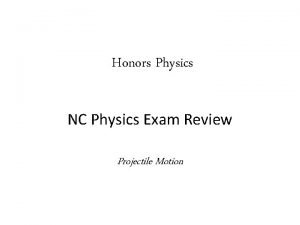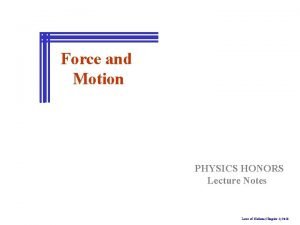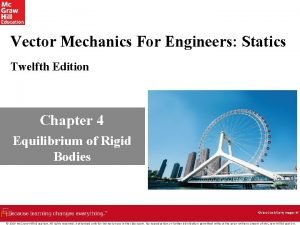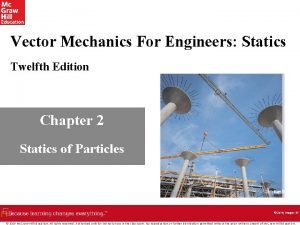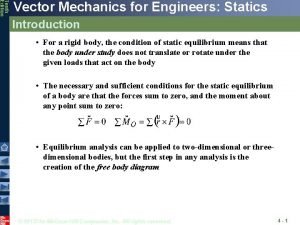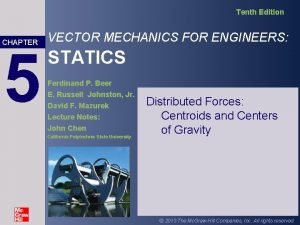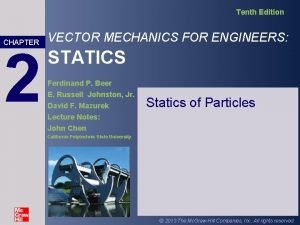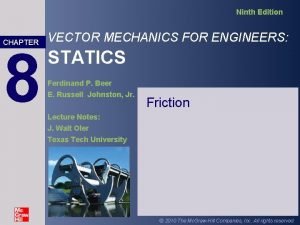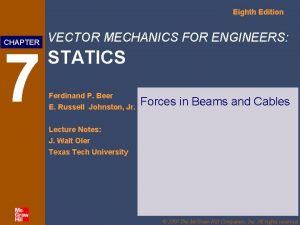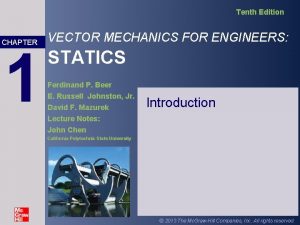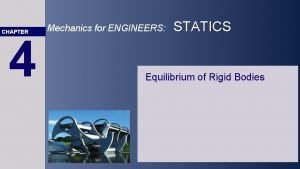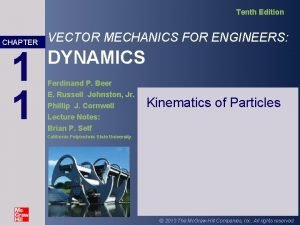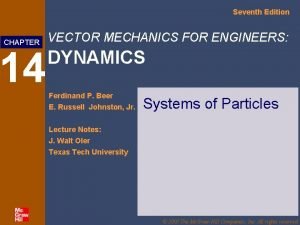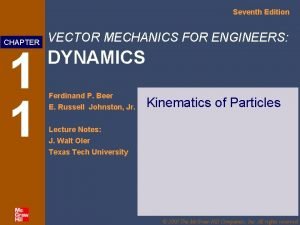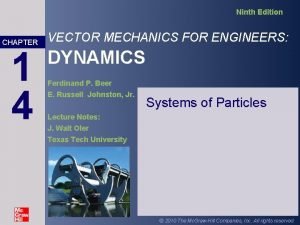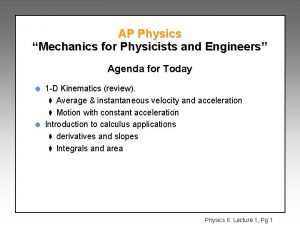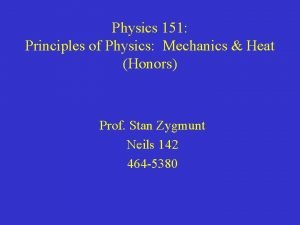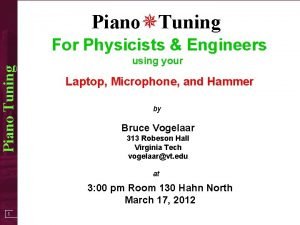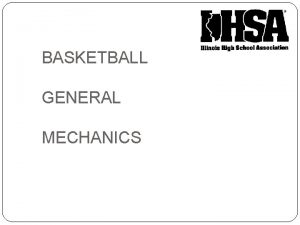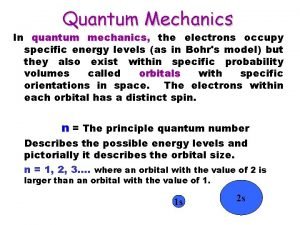Honors Physics Mechanics for Physicists and Engineers Agenda

















- Slides: 17

Honors Physics “Mechanics for Physicists and Engineers” Agenda for Today l l Advice 1 -D Kinematics çAverage & instantaneous velocity and acceleration çMotion with constant acceleration çFreefall Honors Physics : Lecture 1, Pg 1

Kinematics Objectives l l Define average and instantaneous velocity Caluclate kinematic quantities using equations interpret and plot position -time graphs be able to determine and describe the meaning of the slope of a position-time graph Honors Physics : Lecture 1, Pg 2

Kinematics l l l Location and motion of objects is described using Kinematic Variables: Some examples of kinematic variables. çposition r vector, (d, x, y, z) çvelocity v vector çacceleration a vector Kinematic Variables: çMeasured with respect to a reference frame. (x-y axis) çMeasured using coordinates (having units). çMany kinematic variables are Vectors, Vectors which means they have a direction as well as a magnitude çVectors denoted by boldface V or arrow above the variable Honors Physics : Lecture 1, Pg 3

Motion l l l Position: Separation between an object and a reference point (Just a point) Distance: Separation between two objects Displacement of an object is the distance between it’s final position df and it’s initial position d i (d f - di)= d Scalar: Quantity that can be described by a magnitude(strength) only çDistance, temperature, pressure etc. . Vector: A quantity that can be described by both a magnitude and direction çForce, displacement, torque etc. Honors Physics : Lecture 1, Pg 4

Speed and Velocity l l l Speed describes the rate at which an object moves. Distance traveled per unit of time. Velocity describes an objects’ speed and direction. Approximate units of speed Honors Physics : Lecture 1, Pg 5

Motion in 1 dimension l In general, position at time t 1 is usually denoted d, r(t 1) or x(t 1) l In 1 -D, we usually write position as x(t 1 ) but for this level we’ll use d Since it’s in 1 -D, all we need to indicate direction is + or . l l Displacement in a time t = t 2 - t 1 is x = x 2 - x 1= d 2 -d 1 x some particle’s trajectory x 2 in 1 -D x x 1 t 1 t t 2 t Honors Physics : Lecture 1, Pg 6

1 -D kinematics l l Velocity v is the “rate of change of position” Average velocity vav in the time t = t 2 - t 1 is: x d 2 x d 1 trajectory Vav = slope of line connecting x 1 and x 2. t 1 t t 2 t Honors Physics : Lecture 1, Pg 7

1 -D kinematics. . . l l Instantaneous velocity v is defined as the velocity at an instant of time ( t= 0) Slope formula becomes undefined at t = 0 x so V(t 2 ) = slope of line tangent to path at t 2. x 2 x x 1 » Calculus Notation t 1 t t 2 t Honors Physics : Lecture 1, Pg 8

More 1 -D kinematics l l l v 60 1 2 t We saw that v = x / t çso therefore x = v t ( i. e. 60 mi/hr x 2 hr = 120 mi ) çSee text: 3. 2 In “calculus” language we would write dx = v dt, which we can integrate to obtain: Graphically, this is adding up lots of small rectangles: v(t) + +. . . + = displacement t Honors Physics : Lecture 1, Pg 9

1 -D kinematics. . . l l Acceleration a is the “rate of change of velocity” Average acceleration aav in the time t = t 2 - t 1 is: l And instantaneous acceleration a is defined as: The acceleration when t = 0. Same problem as instantaneous velocity. Slope equals line tangent to path of velocity vs time graph. Honors Physics : Lecture 1, Pg 10

Problem Solving l Read ! çBefore you start work on a problem, read the problem statement thoroughly. Make sure you understand what information in given, what is asked for, and the meaning of all the terms used in stating the problem. l Watch your units ! çAlways check the units of your answer, and carry the units along with your numbers during the calculation. l Understand the limits ! çMany equations we use are special cases of more general laws. Understanding how they are derived will help you recognize their limitations (for example, constant acceleration). Honors Physics : Lecture 1, Pg 11

IV. Displacement during acceleration. l l l You accelerate from 0 m/s to 30 m/s in 3 seconds, how far did you travel? What if a car initially at 10 m/s, accelerates at a rate of 5 m/s 2 for 7 seconds. How far does it move? ç df=1/2 at 2 + vit + di C. An airplane must reach a speed of 71 m/s for a successful takeoff. What must be the rate of acceleration if the runway is 1. 0 km long? ç d = (vf 2 - vi 2) /2 a Honors Physics : Lecture 1, Pg 12

Recap l If the position x is known as a function of time, then we can find both velocity v and acceleration a as a function of time! x v a t t t Honors Physics : Lecture 1, Pg 13

Recap l So for constant acceleration we find: x v l t From which we can derive: a t t Honors Physics : Lecture 1, Pg 14

IV. Acceleration due to gravity l l The acceleration of a freely falling object is 9. 8 m/s 2 (32 ft/s 2) towards the earth. The farther away from the earth’s center, the smaller the value of the acceleration due to gravity. For activities near the surface of the earth (within 5 -6 km or more) we will assume g=9. 8 m/s 2 (10 m/s 2). Neglecting air resistance, an object has the same acceleration on the way up as it does on the way down. Use the same equations of motion but substitute the value of ‘g’ for acceleration ‘a’. Honors Physics : Lecture 1, Pg 15

Recap of kinematics lectures l l Measurement and Units (Chapter 1) çSystems of units çConverting between systems of units çDimensional Analysis 1 -D Kinematics çAverage & instantaneous velocity and acceleration çMotion with constant acceleration Honors Physics : Lecture 1, Pg 16

Honors Physics : Lecture 1, Pg 17
 Physics semester 1 review
Physics semester 1 review Honors physics projectile motion test
Honors physics projectile motion test Physics honors notes
Physics honors notes Andrzej nadolny
Andrzej nadolny Matthew's parents are physicists
Matthew's parents are physicists Statics of rigid bodies
Statics of rigid bodies What is line of action
What is line of action Vector mechanics for engineers statics 10th edition
Vector mechanics for engineers statics 10th edition Vector mechanics for engineers
Vector mechanics for engineers Mechanics for engineers
Mechanics for engineers Static mechanics
Static mechanics Vector mechanics for engineers chapter 7 solutions
Vector mechanics for engineers chapter 7 solutions Vector mechanics for engineers 10th edition
Vector mechanics for engineers 10th edition A crane
A crane Vector mechanics for engineers: dynamics
Vector mechanics for engineers: dynamics Vector mechanics for engineers: dynamics
Vector mechanics for engineers: dynamics Vector mechanics for engineers dynamics 12th
Vector mechanics for engineers dynamics 12th Vector mechanics for engineers: dynamics
Vector mechanics for engineers: dynamics

